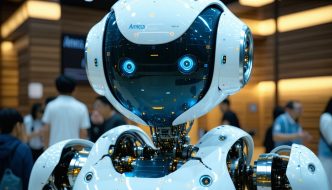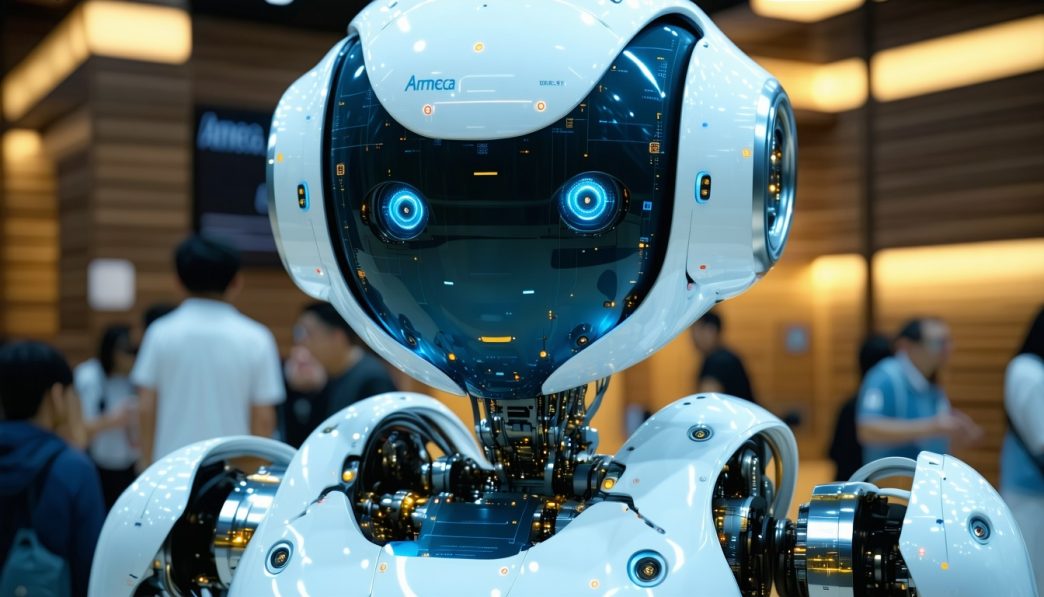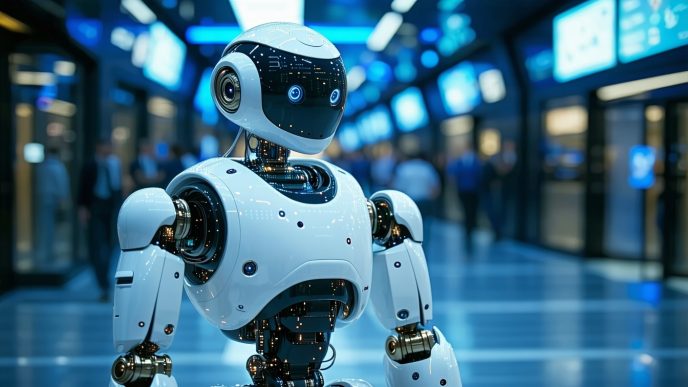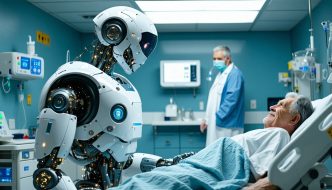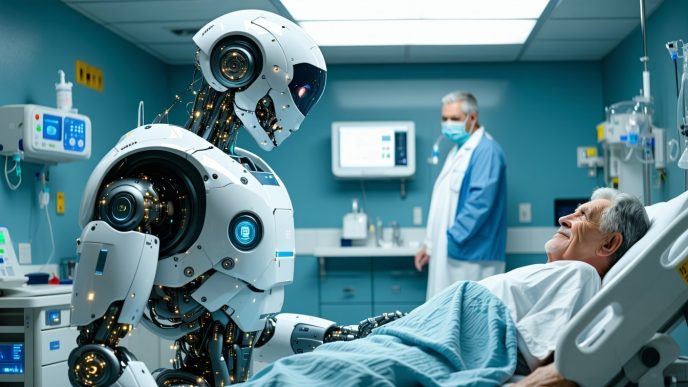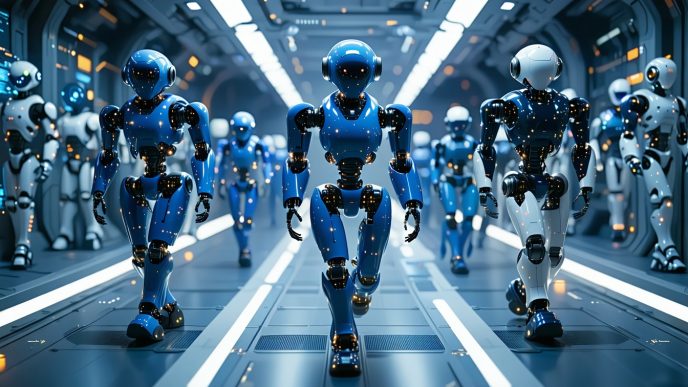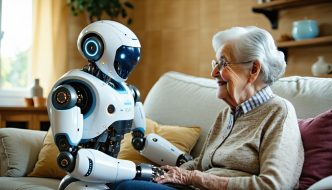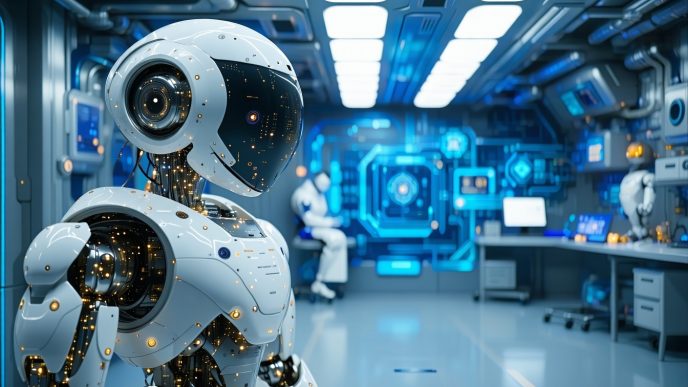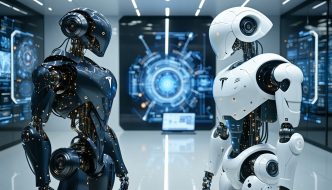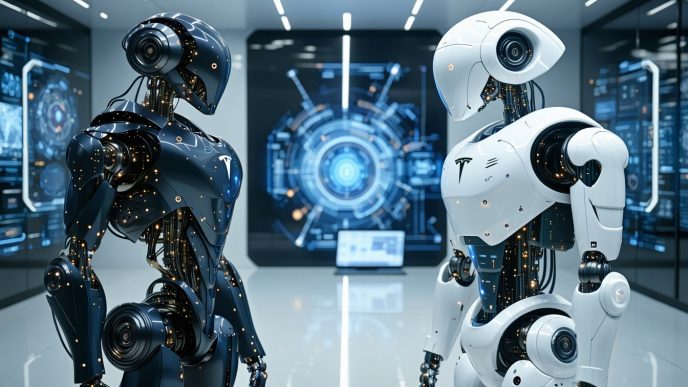Introduction to Humanoid Robots
Humanoid robots are designed to resemble and replicate human physical characteristics and behaviors. They play a significant role in various sectors and can enhance interactions between humans and machines.
Importance of Humanoid Robots in Modern Society
The relevance of humanoid robots in today’s world cannot be understated. These machines offer numerous benefits, including assistance in daily tasks, education, and healthcare environments. Key areas where humanoid robots are making an impact include:
| Application Area | Benefits |
|---|---|
| Healthcare | Provide assistance to elderly and disabled individuals. |
| Education | Facilitate interactive learning experiences. |
| Entertainment | Enhance user engagement through interactive storytelling. |
| Customer Service | Assist in retail settings by answering queries. |
Humanoid robots, like the Ameca robot by engineered arts, exemplify advancements in this field, showcasing their potential to interact humanely and assist with various tasks.
Evolution of Humanoid Robotics
The development of humanoid robots has progressed dramatically over the past few decades. Early attempts focused on basic movements and limited interactions. Over time, advancements in technology have allowed for significant improvements in design and functionality.
Notable milestones in the evolution of humanoid robots include:
| Year | Development |
|---|---|
| 1970s | Introduction of basic humanoid robots such as WABOT-1 in Japan. |
| 1990s | Development of robots with more sophisticated movement and sensors. |
| 2000s | Advancements in AI and machine learning led to enhanced interaction capabilities. |
| 2010s | Emergence of robots like ASIMO by Honda, showcasing mobility and basic communication. |
| 2020s | Introduction of advanced models such as the Ameca robot, which can express emotions and engage in conversation. |
The journey from simple machines to the complex humanoid robots we see today illustrates the rapid developments in engineering and technology. As researchers continue to explore new possibilities, the future of humanoid robotics looks promising. For those interested in specific applications, various articles cover humanoid robots in areas like education, healthcare, and personal assistance.
Ameca: A Breakthrough in Humanoid Robotics
Overview of Ameca
The Ameca robot stands as a groundbreaking development in the realm of humanoid robotics. Engineered with advanced technology, Ameca is designed to replicate human expressions and movements, providing a combination of functionality and engagement. This robot is tailored for both interaction and demonstration, showcasing the capabilities of modern robotics.
Ameca is built with the purpose of serving in various environments, allowing it to function as a companion, assistant, and even an entertainer. Its design blends aesthetic appeal with practical application, making it an exemplary model of what the future holds for humanoid robots.
Key Features of Ameca
Ameca incorporates several notable features that contribute to its reputation as a leading humanoid robot. The following table summarizes its key attributes:
| Feature | Description |
|---|---|
| Facial Expression | Equipped with multiple motors to simulate a wide range of human expressions. |
| Real-time Interaction | Capable of responding to verbal cues and engaging in conversation. |
| Human-like Movement | Advanced articulation allows for natural gestures and movements. |
| Interactive Screen | Includes a display to communicate visual information and enhance engagement. |
| Customizable Appearance | Offers options for customization to fit different environments and purposes. |
The combination of these features positions the Ameca robot by engineered arts as an innovative solution for various industries. Applications can range from humanoid robots for education to humanoid robots in healthcare. As technology progresses, Ameca serves as an example of how robots can integrate into daily life, making them an integral part of society’s future.
The Technology Behind Ameca
Ameca, the humanoid robot developed to reflect human-like expressions and movements, incorporates multiple advanced technologies. These technologies work collaboratively to enhance its functionality and interaction abilities.
Advanced Artificial Intelligence
The advanced artificial intelligence (AI) embedded in Ameca allows it to analyze and respond to human emotions effectively. It utilizes machine learning algorithms and vast datasets to recognize emotional cues from facial expressions and body language. This capability makes Ameca a more relatable and engaging robot.
| AI Features | Description |
|---|---|
| Emotion Recognition | Processes and identifies human emotions |
| Natural Language Processing | Understands and responds to verbal communication |
| Learning Algorithms | Adapts and improves responses over time |
By integrating AI, Ameca not only simulates human interaction but also learns from experiences, enhancing its responses and interactions. For more insights on such applications of AI in robots, visit our article on ai models in humanoid robots.
Human-like Movement Technologies
Another remarkable aspect of Ameca is its human-like movement technologies. The robot features a series of actuators and advanced robotics that mimic human gestures and responses. Its design allows for fluid movements, enabling Ameca to perform a wide range of activities similarly to how a human would.
| Movement Features | Description |
|---|---|
| Articulated Joints | Allows for natural bending and rotation |
| Responsive Mechanics | Reacts to surroundings in real time |
| Balance Control Systems | Maintains stability during various movements |
These movement technologies contribute significantly to Ameca’s overall realism and functionality. For further exploration of locomotion technologies in robotics, see our article on humanoid robot locomotion systems.
Interactive Capabilities
Ameca’s interactive capabilities are at the core of its design. It can engage with people in conversations and react to non-verbal cues, creating a seamless communication experience. The use of voice interfaces and sensory recognition allows for immersive interactions.
| Interaction Features | Description |
|---|---|
| Voice Interfaces | Can engage in verbal communication |
| Sensory Feedback | Responds to physical touch and gestures |
| Real-time Processing | Analyzes interactions immediately |
Such features make Ameca not only an advanced representation of humanoid robotics but also a practical tool in various fields. For insights into voice interfaces in robots, check our article on voice interfaces in humanoid robots.
Through the incorporation of advanced AI, sophisticated movement technologies, and interactive capabilities, Ameca stands out as a prominent example of innovation in humanoid robotics, showcasing the potential future of robotic interaction and integration in society.
Applications of Ameca
Ameca, the advanced humanoid robot, has far-reaching applications across various sectors. Its design and capabilities allow it to serve effectively in the medical field, education and research, as well as in the entertainment industry.
Medical Field
In the medical sector, Ameca enhances patient interaction and care. With its human-like appearance and responsive behaviors, it can engage with patients, providing companionship and comfort. This is particularly useful in settings like nursing homes, where loneliness can be a significant issue. Additionally, Ameca can assist medical professionals during interviews or therapy sessions by providing a non-threatening presence for patients.
Applications in the medical field involve:
| Application | Description |
|---|---|
| Patient Interaction | Engages with patients to reduce anxiety and improve comfort levels. |
| Therapy Support | Aids therapists by acting as an intermediary during sessions. |
| Health Monitoring | Offers reminders for medication and appointments through interactive dialogue. |
Education and Research
Ameca serves as a dynamic tool in educational settings, where it can facilitate learning experiences. This robot can assist in teaching complex subjects by engaging students through interactive demonstrations. Further, researchers utilize Ameca’s advanced AI to study human-robot interaction, contributing greatly to the field of robotics and artificial intelligence.
Key applications in education and research include:
| Application | Description |
|---|---|
| Interactive Learning | Engages students with hands-on learning experiences. |
| Research Tool | Assists in studies of human-robot interactions and AI development. |
| Language Learning | Provides language practice through conversational engagement. |
Entertainment Industry
In the entertainment sector, Ameca has the potential to revolutionize how audiences interact with robots. Its expressive features and responsiveness make it ideal for roles in films, exhibitions, and theme parks. Ameca can captivate audiences by demonstrating emotional responses and engaging in real-time dialogue, adding a new dimension to entertainment experiences.
Applications in entertainment include:
| Application | Description |
|---|---|
| Live Performances | Engages audiences in theater or theme park settings. |
| Film Production | Performs as a character, showcasing advanced AI capabilities. |
| Exhibitions | Captures attention at technology showcases and public expositions. |
Through these applications, the Ameca robot by engineered arts serves as a versatile entity with the potential to transform interactions in various fields. By exploring its uses in medicine, education, and entertainment, stakeholders can fully appreciate the remarkable capabilities of humanoid robotics.
Impact of Ameca on Society
Shaping the Future of Robotics
Ameca robot by Engineered Arts presents a significant advancement in robotic technology, aiming to influence various sectors positively. Its human-like appearance and responsive behavior offer the potential to change interactions between humans and machines, making robots more relatable and accessible.
The introduction of Ameca could lead to broader acceptance of humanoid robots in everyday environments, including homes and workplaces. As the capabilities of such robots expand, they may become integral in areas like humanoid robots for home use and humanoid robots in healthcare. The influence of Ameca could also pave the way for innovations in emotional recognition and social interaction, enabling better responses in various settings.
Potential Impact Areas of Ameca:
| Area | Potential Applications |
|---|---|
| Healthcare | Patient interaction, therapy support |
| Education | Teaching assistants, student engagement |
| Entertainment | Interactive exhibits, performance art |
| Customer Service | Information kiosks, staff assistance |
Ethical Considerations
With the deployment of advanced humanoid robots like Ameca, ethical concerns emerge regarding their integration into society. The primary issues relate to privacy, emotional manipulation, and the potential for job displacement. As these robots become more capable, questions arise about their impact on human relationships and social dynamics.
The ethical implications include the need for guidelines on how humanoid robots interact with individuals and the data they collect. Data protection is critical, as personal information could be vulnerable to misuse. The debate regarding robot emotions and ethics also emphasizes the need for clear protocols on how humanoid robots should respond to human emotions.
Important ethical considerations include:
| Consideration | Description |
|---|---|
| Privacy | Safeguarding personal data collected by robots |
| Emotional Manipulation | Ensuring robots do not exploit human emotions |
| Job Displacement | Addressing unemployment due to automation |
| Accountability | Determining responsibility for robot actions |
As society navigates the integration of advanced humanoid robots like Ameca, addressing these ethical challenges will be crucial to ensuring beneficial coexistence between humans and robots.
Challenges and Future Developments
As innovative as the Ameca robot by Engineered Arts is, it still faces challenges that limit its capabilities and integration into everyday life. Understanding these limitations can guide future advancements in humanoid robotics.
Current Limitations
The Ameca robot, like many humanoid robots, encounters several technological and functional limitations:
| Limitation | Description |
|---|---|
| Limited Emotional Recognition | Current AI models in humanoid robots, including Ameca, struggle with accurately interpreting and responding to human emotions. This restricts their ability to engage in nuanced social interactions. To learn more, see our article on emotion recognition in robots. |
| Physical Constraints | While Ameca can mimic human movements, its locomotion systems are still developing. The limitations in balancing and mobility prevent it from navigating diverse terrains effectively. Explore more on humanoid robot locomotion systems. |
| Interaction Complexity | Despite its advanced AI, Ameca’s interactive capabilities can sometimes be basic. This includes limitations in understanding complex queries or performing tasks beyond pre-programmed responses. For insight into improving interaction, refer to our article on voice interfaces in humanoid robots. |
Future Prospects and Enhancements
The path ahead for Ameca and similar humanoid robots is brimming with potential enhancements that could redefine their roles in society and various industries:
| Prospects | Description |
|---|---|
| Enhanced AI Integration | The development of more sophisticated AI models will improve Ameca’s ability to understand and navigate human emotions, enhancing social interaction and customer service applications. For more on this topic, check our article on ai models in humanoid robots. |
| Improved Mobility Systems | Future developments may lead to advanced locomotion technologies, allowing Ameca to move with greater agility and navigate a wider range of environments. Read about current trends in humanoid robot navigation. |
| Customization Options | As demand grows for personalized interaction, future iterations of the Ameca robot may include customization features for specific industries, enhancing the functionality and application of humanoid robots in homes, healthcare, and education. Consider exploring humanoid robot customization for more details. |
The future of Ameca and humanoid robots is bright, promising enhancements that cater to both technological advancements and societal needs. As challenges are addressed, the integration of these robots into daily life may become more seamless and impactful.
